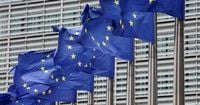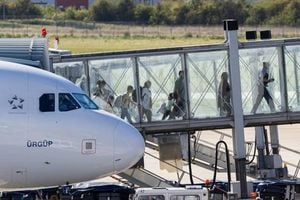As the world pivots in response to President Donald Trump’s renewed “America First” agenda, global trade and diplomatic alliances are undergoing seismic shifts. The United States, once described by Madeleine Albright as the “indispensable nation,” is now stepping back from its traditional leadership role, leaving allies and rivals alike to navigate a more fragmented and unpredictable international landscape. The repercussions of this shift reverberate through economic policy, climate commitments, and even the steelworkers on factory floors from Sheffield to Stuttgart.
Trump’s approach, recently underscored during his address to the United Nations General Assembly in late September 2025, has been marked by skepticism toward multilateral agreements and a willingness to upend established international norms. According to Reuters Breakingviews, this has created a “vacuum in world affairs,” with pressing needs for cooperation on security, climate change, and trade. The risk, as analysts warn, is that if every nation pursues only its narrow interests, the world could be headed for a more fractious and unstable future.
Nowhere is this more apparent than in the realm of trade. The United States, which accounted for only 14% of global imports in 2024, has leveraged its market power with a series of aggressive tariffs. Most recently, the US imposed a 50% tariff on steel imports, a move that has sent shockwaves through the European Union’s already struggling steel industry. The Guardian reports that the pain doesn’t stop there: in August 2025, the US expanded its tariff regime to cover 407 categories of “derivative” products, ranging from wind turbines and mobile cranes to seemingly innocuous items like windows, doors, and even furniture with metal components.
EU business leaders and trade officials are deeply uneasy about this rolling expansion. Luisa Santos, deputy director general at BusinessEurope, described the relationship with the US as “becoming quite turbulent” due to Washington’s ability to arbitrarily add products to the tariff list. “The problem now is that the US is making a strange interpretation of the deals, increasing the list of derivatives. It is not just with us; it is with everyone. It could be a motorbike that is now hit, or a table with a small bit of metal on it or window frames,” Santos told The Guardian. She added, “The issue is if we still have a number of things that are not clear, if you have one side expanding through these lists of derivatives, it is very difficult to claim we have certainty.”
The US opened a new consultation on September 15, 2025, seeking input on further products to include, with a deadline of September 29. EU industry fears that this process, which is set to recur three times a year, will only expand the list, further destabilizing European manufacturing. The UK, which had previously negotiated a lower 25% steel tariff before its own deal with the EU, is now seeking clarification from Washington about which additional products could be affected.
For European manufacturers, the uncertainty is more than academic. Bernd Lange, a German MEP and chair of the European Parliament’s influential international trade committee, recounted his visit to a motorcycle factory in Germany. He explained that manufacturers are now forced to declare the maximum possible steel content in their products—sometimes as high as 50%—to avoid punitive customs penalties, which can reach 200% for incorrect declarations. “They know they are between 30% and 50% but because they are unsure, they declare 50% because otherwise they are in danger of getting tariffs of 200%,” Lange explained. The confusion and risk, he said, make it hard to “explain to the workers” that the EU-US trade relationship is beneficial.
The steel sector’s woes are compounded by overcapacity and the flood of cheap imports, particularly from China. Trade unions and British Steel have called for a pledge to support the UK’s steel sector, warning of potential redundancies and the risk to critical infrastructure. “With the industry facing unprecedented challenges, the pledge seeks to galvanise support for UK-made steel and reinforce the long-term resilience of the sector, its workforce, and the infrastructure it sustains,” they said in a joint statement. Eurofer, the European steel trade body, echoed these concerns, stressing the urgent need for “a strong new trade measure to preserve not only the viability of the EU steel sector but EU manufacturing as a whole, and the millions of quality jobs they sustain in Europe.”
Amid these trade tensions, other global powers are stepping up efforts to fill the leadership void. Canada, for instance, has signed a new trade agreement with Indonesia and a strategic partnership with Mexico, while also working to eliminate internal trade barriers. The EU has deepened its partnership with the UK and finalized deals with India and Mexico, and is inching closer to an agreement with the Mercosur bloc, despite internal opposition from France. Still, as Reuters Breakingviews notes, progress in removing the EU’s own internal barriers remains slow, with ambitious blueprints from figures like Mario Draghi still largely on the shelf.
On climate change, the situation is equally fraught. The US accounted for just 11% of global greenhouse gas emissions in 2023, compared to China’s 26%. Yet, China’s recent pledge to cut its emissions by only 7-10% by 2035—from a peak it may not have reached—has left many disappointed. Nonetheless, international coalitions are emerging. The Inter-American Development Bank, for example, has launched a plan to buy up and securitize loans from commercial banks, provided they reinvest in projects aligned with climate goals. Such initiatives show that, even in the absence of US leadership, progress is possible when willing nations join forces.
Security remains a domain where America’s influence is hard to replace. In Ukraine, Europe is moving toward a “reparations loan” for Kyiv, based on the roughly 140 billion euros in frozen Russian assets. The European Commission, Germany, and the UK have all backed the plan, which would require Ukraine to repay the loan only if Russia pays war reparations. While US support would be welcome, European leaders believe they can move forward independently, given that most of the frozen assets are held in Europe.
In the Middle East, however, America’s clout is still indispensable. The UN General Assembly, with broad support, backed a Franco-Saudi plan for both Hamas and Israeli forces to withdraw from Gaza and hand power to the Palestinian Authority. Yet, as Reuters Breakingviews points out, this initiative is unlikely to succeed without Washington’s involvement. Arab leaders, many of whom maintain good relations with Trump, have at least managed to persuade him to oppose a potential Israeli annexation of the West Bank—a rare instance of diplomatic leverage in a volatile region.
Despite the turbulence, some see a silver lining. The so-called “Pax Americana”—the US-dominated order since World War Two—was never perfect. Now, as the US retreats, other nations and coalitions are being forced to assert themselves and, perhaps, build a more balanced and pluralistic world order. Whether they succeed remains to be seen, but one thing is clear: the old certainties are gone, and the new world is up for grabs.




